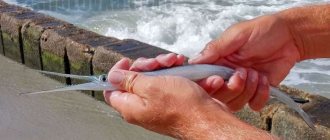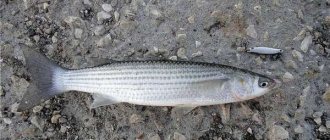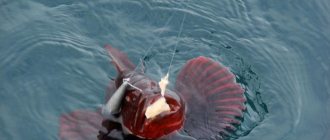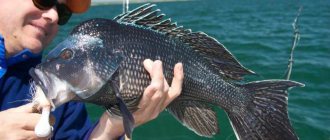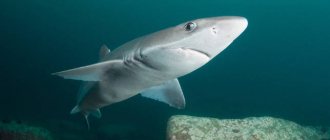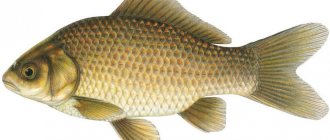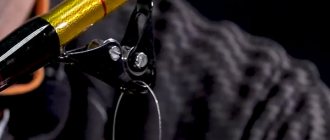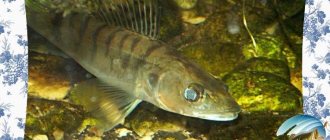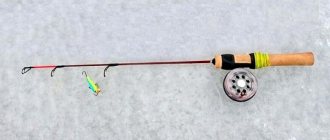Category: sea fishing Tags: jig
Sea fishing with jigs or coastal sea jig is one of my favorite fishing activities. It is energetic and dynamic; you always need to select the color and weight of the jig, its wiring and even installation. When fishing with jigs, you won’t get bored even with a weak bite. In this article I will talk about jig fishing in the Black Sea .
Jig - what is it?
What is a jig ? In fact, a jig is a subspecies of an oscillating spoon. But unlike the classic wobble, which is designed for uniform retrieves with a smooth shedding during pauses, a jig is needed for more aggressive, jerky retrieves. That is, the main game of the jig is set by the fisherman himself, performing various manipulations with the rod when retrieving.
Although you shouldn’t think that jigs don’t have their own game, this is far from the case. Due to their shape, many jigs play even on even retrieves. Again, due to its shape, each jig moves differently in jerks. Also, any jig has a shedding game when the angler pauses between jerks. Of course, even the most flattened jig will sink much faster than a classic oscillating spoon.
So what does a fishing jig look like? Jigs most often imitate fry or small fish, which constitute the main food supply of pelagic marine predators. For example, many jigs imitate anchovy in shape.
Jigs are made from various metals and metal alloys. Handmade jigs are cast from lead, tin, or alloys of these two metals. Factory jigs most often have more complex metal alloys. In any case, due to the fact that the jigs are made of metal, they have a decent weight and are compact in size. A jig 4-5 cm long can weigh 10-15 g.
Compact dimensions and good weight make the jig a long-range bait and allow you to fish over long distances, and this is very important when fishing at sea. Also, the compact size and good aerodynamic shape make the jig less saily, thereby allowing you to make a good cast and catch even in strong winds.
It is worth noting that the baits discussed in this article are called differently: jig, metal jig, jig, “piece of iron” (as they are called by the older generation). What do you call a jig?
Design features and applications of jigs
Their catchability was also in demand when fishing in reservoirs and rivers within the country. The best examples of jigs for cod turned out to be no less popular among fans of fishing for pike perch, asp, pike and perch, both plumb and when jigging. Their size and shape have changed somewhat, but the equipment remains the same. But the high cost of such spinners is increasingly forcing local fishermen to make jigs with their own hands.
First of all, it should be noted that the best jigs for sea fishing are heavy spoons for vertical lures. They can be classified according to several characteristic features:
- First of all, by weight. Based on this indicator, jigs are selected depending on the fishing conditions. Depending on the speed of the current, the depth of the bait and the wind speed, it can reach up to 700 and even 1000 g.
- According to its design features. They can be round, tubular, polyhedral and flat. Traditionally, homemade jigs for cod have an aspect ratio of 6:1. Moreover, their thickness correlates with width as 1:2 and, in some cases, as 1:1.
- According to the material of manufacture. These can be stainless or chrome-plated tubes filled with lead. Often there are samples made from profiled steel rods. When making homemade jigs for cod fishing, brass, cupronickel, copper and stainless steel are often used, with lead, sand and tungsten used to balance them.
Important! The cost of sea spinners of this type sometimes reaches up to 25 € per piece, and their life expectancy is no more than two or three hours. That is why the ability to make jigs for sea fishing with your own hands is not only tactical, but also purely economic.
What types of jigs are there?
The jig is a classic sea bait. But with the same success, jigs are also used in freshwater fishing, for example, when catching asp and perch. Marine and freshwater jigs do not differ in shape and appearance.
There are two main types of jigs :
- Fast jig – for fast jig. These jigs have an elongated body and the least resistance during flight and retrieve. These jigs are designed for fast, aggressive retrieves. This type of jig in the Black Sea is best suited for catching garfish, but also works well for other pelagic predators such as horse mackerel and bluefish.
- Slow jig – for a slow jig. These jigs have a more flattened body and generally more complex geometry. Slow jigs are suitable for smoother retrieves with long pauses. These jigs have a more active action on the breakup. They are universal and catch almost all fish in the Black Sea, but they perform best when fishing for horse mackerel.
- It is clear that there are a lot of types and shapes of jigs and there are models that, according to their purpose, are somewhere between fast and slow jigs. They fish excellently both on fast retrieves in the upper layers of water and on retrieves with long pauses.
Features of catching predators with jigs for sea fishing
Fishing at sea or in large freshwater areas forces the spinner to stock up on heavy artificial baits. Only in this case can you count on a good catch. One of the most effective types of spinners are jigs for sea fishing. They allow you to hunt both in the vast expanses of the sea and in deep freshwater reservoirs. What are jigs, what types are there, and how to use them?
A distinctive feature of all jigs is the elongated purlin shape of the body. Essentially, this bait is a heavy oscillating spoon. On one side of the jig there is a soldered loop for fastening with fishing line, on the other end a treble hook is attached to the same loop. To give the bait more mass while maintaining a narrow elongated body, manufacturers use several technologies.
- The simplest way to make spinners of this type is to use a profile wheel. The workpiece is cut on both sides at a certain angle, holes are made at the ends or loops are soldered.
- Many spinning anglers are familiar with the homemade tube bait. Some jigs are made from a tubular material that is then filled with lead.
- A number of manufacturers cast all bait from lead in special molds. As a result, the body of the jig resembles a live fish.
- Triangular baits are made from a metal sheet, which is first bent into a triangular profile, followed by soldering the seam. The internal cavity is filled with molten lead.
Photo 1. Installation of the jig.
Jigs can be used both in open sea conditions and in wide freshwater areas. Drawing a line between marine and freshwater models is quite difficult.
- In general, jigs for sea fishing are distinguished by their larger dimensions and greater weight. Such properties of the bait allow you to successfully hunt cod, halibut or catfish. Fishing is carried out from a boat or ship in a vertical position.
- You can catch freshwater predators such as pike perch and asp with more compact models. Since fishing is most often carried out using the jig method, the flight characteristics of baits come to the fore. Although vertical fishing from a boat is also quite effective.
Sea and freshwater jigs can be divided into several groups. One classification is based on the manufacturing method. However, in this division there is no relationship with the game of the bait. In this regard, it is better to adhere to the following gradation, which takes into account the shape of the body.
- The most popular among anglers today are jigs with a narrow molded body shape. They have a characteristic bend located in the tail area. Thanks to this geometry, the jig has an attractive action for predators.
- In some modifications the upper part of the bait is heavier. This jig is good because it works equally effectively both when fishing vertically and when fishing with a classic step. Thanks to the heavy head, the spinner has a vertical component of the game.
- Vertical spoons, converted into jigs by cutting the head and tail parts, are also in demand among fans of spinning rods. It is important that the head of the bait remains heavier than the tail.
- For vertical spinning or jigging, anglers often use elaborately shaped jigs with a large number of edges. Such a bait in the water forms an alternating play of light that attracts the attention of a predator.
How to rig a jig?
An important question is how to rig a jig ? In fact, there are a lot of equipment options and their number is only growing every year. We look at some jig equipment from the Japanese, and come up with some ourselves. But the most important thing to understand is that there is no such thing as incorrect jig equipment; every proven installation will work better in some certain conditions, and worse in others. You definitely need to experiment!
The installation of a jig, most often, consists of two hooks: the main hook (attached to the back ring, like an oscillating spoon) and an auxiliary one, it is called an assist hook (attached to the front ring using a special cord). Let's take a closer look at the installation of each hook:
- In the classic version, the main hook of the jig is the tee. Less often they use a single hook (although this jig installation is quite effective, especially for garfish), or two single hooks at once.
- Also, the main hook of the jig can be tied on a retractable leash. A fluorocarbon leash 10-15 cm long is tied to the jig. A triple or single hook is tied at the end. In this installation, the main hook is often decorated with lurex.
- The assist hook also has many variations: mainly 1 or 2 single hooks decorated with lurex are used. The hook is tied with a cord to the upper eye of the jig. If there is only one hook, then it should be in the upper third of the jig. If there are 2 hooks, then 1 of them is attached in the upper third, and the second one is slightly lower in the middle of the jig. Less often, both hooks are at the same distance.
- Also, jig installations are not uncommon, where there is only an assist hook without the main hook. This jig equipment is used in the Black Sea when fishing in areas with a rocky bottom, where a triple hook at the end guarantees a dead hook.
The idea of a retractable leash with a hook for a jig is as follows: when a garfish is not very active, it will prefer smaller prey and grab the fly rather than the jig itself. Also, sometimes a predator chases the bait, but does not catch it. In this case, such a montage provides a chance to turn up the modest fish.
The assist is pretty important. Often the fish attacks the head of the bait, where there is no hook, and in the absence of a hook assist, it is not detected. Also, when fishing for garfish, the jig assist often digs into the fish additionally, even if the garfish was initially sitting on the bottom hook. Thus, the assist reduces the number of garfish escapes. When fishing for horse mackerel with a jig, using an assist hook sometimes allows you to get doublets (two fish at once per retrieve, one on the main tee, the second on the assist).
How to tie a jig?
Tying the jig is very easy. A fluorocarbon shock leader is attached to the main cord. The knot and length of the leash are used at the discretion and taste of the angler. I use an “old bride” knot, and I always measure the leash by eye, about 50-70 cm. The thickness of the leash is selected based on the fishing conditions and the gear used; I most often fish with 0.23 mm thick fluorocab. I have been using Sunline Siglon FC fluorocarbon for 2 seasons now. A clasp is attached to the leash, some use a swivel clasp. However, I did not notice any particular benefit from this.
The fewer parts there are in the installation, the more reliable it is and the less algae that hangs on it during wiring. And algae is a real problem when fishing with jigs in the Black Sea, especially when it is stormy. But I wouldn’t recommend giving up fasteners altogether. After all, sometimes you have to change jigs literally after 2-3 retrieves in order to find a suitable one that the fish will like.
Another interesting installation with which you can tie a jig is the use of an insert with a sub. 2-3 flies are tied to a fluorocarbon leash (the number is at the discretion of the angler); lurex flies are most often used, but more interesting options can be knitted. A fastener is attached to the end of the leash, onto which the jig is placed. Thus, there are more stimuli for the predator, which means there is a greater chance of attack. Also, this installation allows you to catch several fish at a time, this is especially true when fishing for horse mackerel.
Spinning rod for jigs
Spinning for jigs is the choice of every angler based on personal experience and preferences. In general, there are spinning rods designed for metal jig fishing. There are spinning rods for shore jigging, there are ones for fishing from a boat, if you are fishing with baits of 100 grams or more, and there are ones for light baits.
Specialized models for fishing with light jigs are often marked “Light game”, “Light Shore Jigging” and others. These spinning rods are available from Japanese manufacturers, such as Yamaga Blanks in the Blue Current series, Xesta, Tict and others. But unfortunately, the price tags for these rods are far from budget, and a novice angler will not be able to appreciate all the advantages of top-end rods due to lack of experience.
So what kind of spinning rod should be used for jigs in order to fish with them in the Black Sea? Let's look at it in order:
- Length. You shouldn’t go too small with the length of the spinning rod for jigs. It doesn’t matter whether the fishing takes place from a pier or from the beach, a spinning rod shorter than 240 cm in height should not be chosen. I consider the length of a spinning rod for jigs to be 250 cm universal; it will be comfortable for fishing from the pier and from the shore. But if fishing takes place exclusively on the shore or concentrations of fish are often located at a sufficient distance from the pier, you should think about buying a spinning rod with a length of 2.6-2.8 m.
- Tabular or Solid. For jig fishing, take only rods with a tabular tip. Soft solid tips will only interfere with wiring and prevent normal animation. They are needed for something else, for example, for rock fishing (although in this style of fishing many anglers prefer stricter sticks with Tabular or Hard Solid tips). Hard solid tips are also suitable for jig fishing.
- Build. It is advisable to choose spinning rods with a fast action or, even better, a regular fast action. These rods are best suited for jig fishing.
- Test. Since the main objects for fishing with jigs in the Black Sea are not very large, you should not use very large baits. But it’s also not worth getting smaller. The optimal top test for a spinning rod will be 12, 15, 18 g. In the summer, a lighter spinning rod with a test of up to 10-12 g will be enough, but in the fall, when strong winds blow, a jig of 15-18 g will seem like fluff. I also fished with heavier jigs of 30-35 g, but this did not bring good results. But even a medium mackerel, and sometimes small ones, readily grab a jig of 20 g.
- Power. The rod should not be overly powerful. Fishing should be fun. Sea fish, even small ones, are very strong, but if you catch Black Sea garfish with a spinning rod that was designed to catch sea bass, you will not feel all the joy of fishing.
- Weight. The lighter the rod is, the more comfortable it will be to fish with and the more sensitive it will be. Typically, the lighter the spinning rod, the more expensive it is. But even in a budget pricing policy you can find something that is not a log. So if you have a choice between two inexpensive rods with the same characteristics, take the one that is lighter.
- Brand and price. I will say from personal experience that a normal rod for jig fishing can be found in the price segment even up to 3 thousand rubles. For example, I fished with a Royal Spirit spinning rod from AliExpress and overall I was very pleased with it. In 2021, I fished with a Favorite Impulse 832L-T spinning rod. This rod is already at a higher level and gave me even more positive emotions. I will write a review about all the spinning rods that I used for jig fishing in the Black Sea, so subscribe to updates so as not to miss new publications.
Pay attention to the fishing line characteristics of the rod; it is advisable that the PE value should not be higher than 0.8. The optimal value will be 0.2-0.6, 0.3-0.6, 0.3-0.8 PE for spinning rods with bait tests up to 20 g. If the spinning rod has an upper bait test of 25, 30 or more grams, then in this case the upper PE value will be optimal in 1-1.2 PE.
Fastening equipment under heavy loads
A little more about fastening. Carabiner or swivel, etc. We recommend attaching the bait, based on the experience of our trips to the sea, when quite large loads are placed on the tackle, without using fasteners. Those. when large fish are caught, often more than 10 kg.
Tips for fisherman: Sea fishing in Murmansk for cod - Tips for a beginner
For heavy loads on the tackle, we do not use fasteners, but only use winding rings and swivels.
In principle, changing a pilker with a winding ring does not take much longer than using a clasp. Just take the swivel and put it on the winding ring (Photo 14). It turns out that an extra part with reduced reliability - the clasp - has disappeared. All that remains is a forged stainless steel winding ring, a reinforced marine swivel and a self-tie on a 0.5 cord (Photo 15). The sea tackle turns out to be extremely reliable.
We recommend using a self-tie when fishing. Equip your jigs with either a simple tee, or a tee with an edge, or two tees, or in any configuration you like.
Our recommendation is that the top mount for the punda (for the cone jig) is still preferable.
Recommended age for viewing the site is 18+
Posted by mihailk, May 19, 2009, 11:45:49 AM
0 Users and 1 Guest are viewing this topic.
- Fishermen's forum
- ► News from reservoirs
- ► Fishing in the Krasnodar region (Moderator: GAVRISH)
- ► Fishing on the Black Sea
- Advertising on the portal | Contacts | Help | Terms and rules | Up ▲
- SMF 2.1 Beta 4 © 2021, Simple Machines | Site Map
Recommended age for viewing the site is 18+
The page was created in 0.022 seconds with 20 requests.
Read reviews. See if other customers like the saltwater jigs. Read real reviews about the product - you will find a lot of useful information, as well as tips and tricks for convenient shopping.
jigs for sea fishing of good quality and at an affordable price? We know where to look! On AliExpress you can find everything by keywords, for example, jigs for sea fishing - you will get great deals and save money. Here's a quick guide on how to find the lowest prices and highest quality products.
Use filters. AliExpress has a wide selection of a wide variety of products. To find jigs for sea fishing according to your parameters, set up filters and sort everything by relevant results, number of orders or price. You can also choose filters with free shipping, fast delivery or free returns.
Research brands. Saltwater fishing jigs from trusted and well-known brands you love - just click the brand logo on the left sidebar. This will help you filter your search results.
Read reviews. See if other customers like the saltwater jigs. Read real reviews about the product - you will find a lot of useful information, as well as tips and tricks for convenient shopping.
This will make it easier to find jigs for sea fishing at a good price and benefit from fast delivery or free returns. And special offers and gifts await new users! Visit the AliExpress website to find and buy even more products from the category.”
This tactic is suitable for fishing with jigs and spoons. Fishing for garfish with a spoon sometimes produces large catches of quite large individuals. Although this type of equipment is less popular than organic bait.
What do you catch with jigs?
Like many spinning baits, the jig is designed to catch predatory fish. In the Black Sea, they mainly catch garfish and horse mackerel using jigs, but also laskir, bluefish, scorpionfish, sea dragon, sawfish and other predators. By the way, there are also cases when small mullet (chulara) also bite on the jig.
In freshwater bodies of water, fishing with jigs is not so common, probably due to the fact that lakes often have dense vegetation and shallow depths, and jigs sink quite quickly and cling to everything. Also, freshwater predators like a smoother presentation of the bait, unlike sea predators (although it happens the other way around, these are fish...).
Nevertheless, in the summer you can successfully catch perch using small jigs up to 10 g. It is also not uncommon to catch asp and other river predators using jigs.
Features and types of jigs
In the classical sense, a jig is a heavy, narrow-bodied spoon, the ratio of length to width is about 6:1. Many models have a round, hexagonal, rectangular or square section. The weight of the bait is decent, allowing you to quickly deepen it and keep it in the fishing zone, regardless of the strength of the current.
This category of baits is widely represented on the market. However, many models have a high cost, so anglers make jigs with their own hands, giving them the necessary characteristics, adapting them to specific fishing conditions and types of predatory fish.
Broadly speaking, the category of artificial lures “pilker” includes diverse narrow-bodied oscillating spoons. They can be divided into the following groups:
Sea jigs have a weight that can even reach a kilogram. They are not suitable for use in freshwater bodies. But small models of these spinners have taken great root among spinners and are used on rivers, reservoirs and lakes, catching asp, perch, pike perch, catfish and pike. For example, any jig for horse mackerel that allows you to successfully hunt for it in the water column will be suitable in closed reservoirs.
Advice! In the rivers and lakes of our climate zone, the most acceptable jigs are baits weighing 15–40 grams and no more than 7–8 cm long. In some cases, the size of the spoon can be increased or, conversely, reduced.
Fishing with a jig has its advantages:
Tips for fisherman: Jig for sea fishing for garfish - What is the difference, pros and cons
Fishing with jigs is problematic in difficult conditions. It is not suitable for snags or areas heavily overgrown with algae.
A jig is essentially an oscillating lure that looks like a metal rod with an oblique cut in the head and tail. In addition, the jig can have edges throughout its body. An ear is soldered into the upper part for attachment to the fishing line; in the lower part, a treble hook or a pair of single hooks on short leashes with lurex are attached to a loop of the same type through winding rings.
How to fish with a jig?
Now let's figure out how to fish with a jig . However, this is not a very tricky matter and if you are already familiar with spinning fishing, you will quickly figure out what’s what. We cast, take out the slack, lower the jig to the desired depth and start retrieving.
What types of jig wiring are there? In fact, wiring a jig is a purely creative matter for every angler. After a season of fishing, everyone develops their own movements, jerks, sequences that work best. The only true thing I can advise is that you shouldn’t try to fish with even movements; periodically you need to make at least a small jerk and a short pause!
Also, you should not do only monotonous wiring with uniform pauses and jerks. Try to diversify the wiring, alternating a long jerk and a short one, a short pause and a little longer. For example, an interesting wiring would be the following: short, short, long jerk, pause, long again, long and two short jerks and pause again.
You should also change the direction of the jerk. The jerk can be done to the right or left, directed downward, and so on. This year I really liked fishing with jigs thrown up and long pauses. This fishing has proven to be especially effective for horse mackerel.
Also, don’t get hung up on one template wiring. If the fish does not respond to changing colors, shapes and weights of baits, try changing the wiring. Change the fishing horizon, increase the fishing speed or, on the contrary, slow it down, take more pauses and longer ones.
To summarize, the correct placement of the jig is the one at which the fish bites, and the rest is a matter of creativity for each angler. And the best way to learn how to fish with a jig is through experience gained while fishing.
When and where to fish
Sargan is a very elusive and unpredictable fish.
It often appears close to the shore, as it hunts small fish, but just as easily leaves from there. It is best to catch it in cold weather, starting from the end of August, as garfish do not like warm water. In hot weather it goes deeper. During bad weather and storms, he also hides. In winter it is quite easy to catch in calm and sunny weather. In February, the fish begin to prepare for spawning, so they gather in groups: a female and several males. Therefore, from March (spawning time) until the end of April, it stays near the shore. However, all these dates are quite approximate, since, depending on the year, they may shift by a couple of weeks. The most active bite is observed in the early morning and late evening. Fish most of all loves the most calm weather and clear water. It is worth avoiding places where rivers flow into the sea, as they often bring muddy water with them and scare away the garfish.
How to choose a jig?
Choosing a jig is not so easy. Now there are a lot of them, but which one should you choose? I recommend diversifying your arsenal of jigs with at least a couple dozen. Fish is unpredictable, one jig may work today and another tomorrow. Actually, this can be said about silicone baits, wobblers and even baits for peaceful fish.
You should not buy jigs of the same type in different colors; 2-3 colors of one model are quite enough. Try to diversify your arsenal of jig models (shapes) as much as possible. Different models of jigs have different action.
It is also worth diversifying the choice of bait weights. You need to have both small weights at the bottom of the spinning rod test and the maximum weights allowed for a spinning rod. There will be a storm, strong wind - the greater the weight of the bait, the more comfortable it will be to throw and catch. The weather will be good, the fish will be capricious, perhaps small jigs will be able to stir it up.
Color is a stumbling block for all spinning lures. My experience suggests that color, although secondary (after shape and weight), is still an important parameter. So it’s worth choosing a jig based on color. First of all, you should take natural colors, silver, greenish and bluish. You definitely need to have at least several models in bright or acidic colors, for example, yellow, orange, pink.
Decoration on the jig (dots, stripes, waves, etc.) can also have a positive effect on the bite. It is also worth choosing a jig with gradient colors, for example, silver turning to yellow and the like. This year, a rainbow-colored jig (until it shot off) worked well for me.
If you plan to fish at dusk or in the dark, you should definitely choose a light-accumulating jig! Without it, normal fishing in the Black Sea at night, most likely, will not work. The jig can be partially luminous (having dots, stripes, or simply partially covered with luminous paint) or completely luminous. It is advisable to have both options.
And now the most important question for many: should you choose expensive Japanese jigs or relatively cheap Chinese copies? If finances allow, it is better to buy branded jigs. Many excellent jigs, tested in the Black Sea, are produced by Hayabusa, Xesta, Ecogear, Maria, Major Craft and others.
But you can successfully fish with more budget models of jigs. Moreover, in many respects they repeat or even copy the shapes and colors of famous brands. I very often fish with budget jigs from AliExpress. Now there is a very good selection of fairly high-quality jigs, for example, I really liked the jigs from AllBlue.
You can also choose handmade jigs, especially if they have positive reviews.
Bait for garfish
Since the majority of fish are average in size, the bait is selected in accordance with these parameters. They use fry, maggots, shrimp, mussels and just small pieces of meat or fish. It is important that the contents of the hook are oblong in shape, reminiscent of natural prey. It’s a good idea to leave the skin on it - for fidelity and greater naturalness.
Tips for fisherman: Sea fishing in Crimea from a boat - Detailed review
Garfish also react quite well to artificial baits - silicone worms, wobblers, small spoons. They, like natural ones, must be thrown as far as possible. For gravity, professionals use a bombard.
Many people dream of Europe, some dream of America, even some go to live for permanent residence in other foreign countries, including the countries of Europe and America. But I like living in Russia, after all, I was born and raised here.
Life in Estonia is just as simpler for Russian citizens. Despite the fact that only citizens of the country who know the language well and have an Estonian passport can get a job in government agencies, there is a good opportunity for Russians to engage in private business. Here the authorities of the country do not restrict Russians in anything.
And I like living in Russia, Europe is good for traveling, but not for living
Many people dream of Europe, some dream of America, even some go to live for permanent residence in other foreign countries, including the countries of Europe and America. But I like living in Russia, after all, I was born and raised here.
Where is a good place to relax in Montenegro?
Montenegro, or Montenegro, is considered one of the most popular countries among tourists. There are many things that attract people here - the historical heritage, the mild climate, the favorable location by the sea, and the developed infrastructure. After all, initially, the government of the country took one direction - the development of tourism. For this purpose, many new comfortable hotels and entertainment centers were built.
The best fishing spots in Finland
The best region for fishing in Finland is the Mikkeli region and Lake Saimaa. Lake Saimaa is the largest lake in Finland and the fourth largest lake in Europe with a total area of 4,380 square kilometers. What’s especially convenient is that the fishing paradise is located just an hour and a half drive from the Russian border. You can go fishing with a guide or on your own. Those who like to relax in a large group will find a wonderful selection of cottages in the region to suit every taste.
How to catch tench
We are not talking about a fish, so small and graceful, but about a real trophy. Let's talk about tactics for catching large tench.
Catching carp is not that easy
Before you start the fishing season, you first need to check your gear. Fishing rods and lines for carp must be very strong to withstand the heavy weight of the fish, which sometimes reaches from 9 to 13 kg or more.
The pike picked itself up
At the beginning of April, my friends and I went fishing to Deima. We reached the fishing spot - upstream from Polessk - at half past ten in the morning. While we prepared the gear and decided who would fish where, another half hour passed.
Bad weather is not a hindrance
Before going fishing, I try to find out where the good bite is at this time. Where is the easiest place to get reliable information? Of course, in a fishing store.
Wobblers Rapala JOINTED
Its developers called this wobbler model JOINTED. This is the ORIGINAL version of the wobbler. The JOINTED bait showed excellent results when used during fishing using the “track” method and with a spinning rod. JOINTED plays a very lively game in the water when retrieving. Thanks to this quality, the wobbler gives good results when used in cold water, when the fish behaves passively due to lower temperatures, or when the bite is poor for other reasons.
Where to buy a jig for sea fishing?
Where to buy a jig for sea fishing, in particular for fishing in the Black Sea? Look for jigs in stores in your city; it’s also worth looking at these baits on bulletin boards; you might find excellent handmade models. Of course, jigs can be purchased online. Below you will find links to stores that have a good selection of jigs.
- Jigs ALLBLUE
- Other jigs on AliExpress
- Japanese signature jigs
- If any of the above links have stopped working, please let us know via the feedback form.
Don't forget to use cashback if you buy on AliExpress. One of the best and proven services for this is LetyShops.
Friends, you have the opportunity to be the first to know about new publications! To do this, subscribe to site updates (don't forget to confirm your subscription by clicking on the link in the email). Also subscribe to our groups on social networks: Vkontakte, Instagram.
Don't forget to share with your friends!
Comments • 16
Listen, I recently bought 2 castmasters of 10.5 grams each, do you think the garfish will work fine?
Tips for fisherman: Spinning rod for sea fishing from the shore - All the nuances
Dear man, please tell me, I also live in Crimea and have a desire to catch garfish, actually the question arose about buying a fishing rod, so, what length should I take the ultralight? The sellers advise me to use 2.7, so you’ll keep throwing, but I read about this length and it seems like it’s not very suitable for other fishing
Take 2.40 it is universal, both for the sea and for rivers
Sergey fishing period from September 1 to September 15. In the store, Golden Catch is your favorite: Ferina, Sandeel, or Arrow? For the first half of September. You can PM me by email or 0982316220 Viber Thank you in advance. We are going to Yuzhny for two weeks, we need to buy something.
Take Genchik Halko, you won’t go wrong
